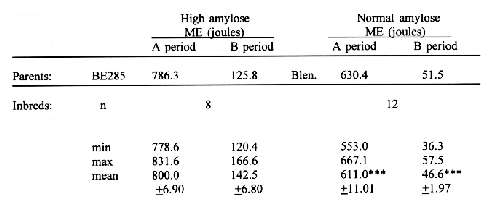

The amo1 (high amylose) gene in barley, located on chromosome 5S, by use of RFLP markers (Schondelmaier et al., 1992), adversely affects malting quality (Ellis, 1976), but high amylose starch may be of value in other areas e.g. in foods suited to special diets (Bjorck et al., 1990). Also, comparison of starch variants may aid the understanding of the process of starch synthesis in barley, so inbred lines carrying the amo1 gene will be produced.
The iodine-binding capacities of amylose and amylopectin differ greatly and absorption spectra of the complexes with iodine show maxima at different wavelengths (HovenkampHermelink et al., 1988). By comparing the absorbance at 2 wavelengths, the amylose content of barley grain may be calculated (Schondelmaier et al., 1992). This offers an inexpensive screening test as an alternative to the use of closely linked molecular markers to select for amo1, but the grains must be milled and extracted in perchloric acid.
The milling energy test measures the mechanical energy required to disrupt the endosperm structure of barley grain. It is used as a rapid screen for malting quality (Allison et al., 1979), as barleys with low milling energy are generally modified more easily in the malting process. Milling energy, determined from the deceleration of a flywheel caused by a sample's resistance to milling, is measured twice, at 2 sec. intervals. In most samples, nearly all the milling occurs in the first two seconds, called the A period (Allison et al., 1979). High values for the second, or B, period are unusual.
Inbred lines were developed as doubled haploids (DH), via anther culture, from a cross between the cv. Blenheim and a breeding line designated BE285, the latter developed at the Scottish Crop Research Institute by backcrossing the amo1 gene from Glacier Pentlandfield into the cultivar, Midas. Twenty DH lines, grown in a trial in four replications, were screened for amylose content (Schondelmaier et al., 1992) with the modification that barley flour was dispersed in 1M NaOH for 30 min. and the solution neutralized with 1M HC1 (Karkalas, 1985), before mixing with iodine/potassium iodide solution. Millingenergies were recorded with a Comparamill (Allison et al., 1979).
Inbred lines carrying the amo1 gene had both an increased milling energy A and also a very high milling energy B (Table 1). As up to 150 previously weighed samples can be milled in 1 hour, milling energy thus offers a potentially very rapid means of selecting for high amylose. Additionally, it shows an effect on the physical structure of the endosperm associated with amo1, which increases both the resistance to milling and the time required to crush the grain into flour. Future research will be directed towards identifying the nature of this effect and determining whether similar changes are observed in other variants of starch granule structure or composition.

References:
Allison, M. J., I. A. Cowe, R. Borzucki, F. M. Bruce, and R. McHale. 1979. Milling energy of barley. J. Inst. Brew. 85:262-264.
Bjorck, I., A. C. Eliasson, A. Drews, M. Gudmundsson, and R. Karlson. 1990. Some nutritional properties of starch and dietary fiber in barley genotypes containing different levels of amylose. Cereal Chem. 67:327-333.
Ellis, R. P. 1976. The use of high amylose barley for the production of whisky malt. J. Inst. Brew. 82:280-281.
Hovenkarnp-Hermelink, J. H. M., J. N. De Vries, P. Adamse, E. Jacobsen, B. Witholt, and W. J. Feenstra. 1988. Rapid estimation of the amylose/amylopectin ratio in small amounts of tuber and leaf tissue of the potato. Potato Res. 31:241-246.
Karkalas, J. 1985. An improved enzymic method for the determination of native and modified starch. J. Sci. Food Agric. 36:1019-1027.
Schondelmaier, J., A. Jacobi, G. Fischbeck, and A. Jahoor. 1992. Genetical studies on the mode of inheritance and localization of the amo1 (high amylose) gene in barley. Plant Breeding 109:274-280.